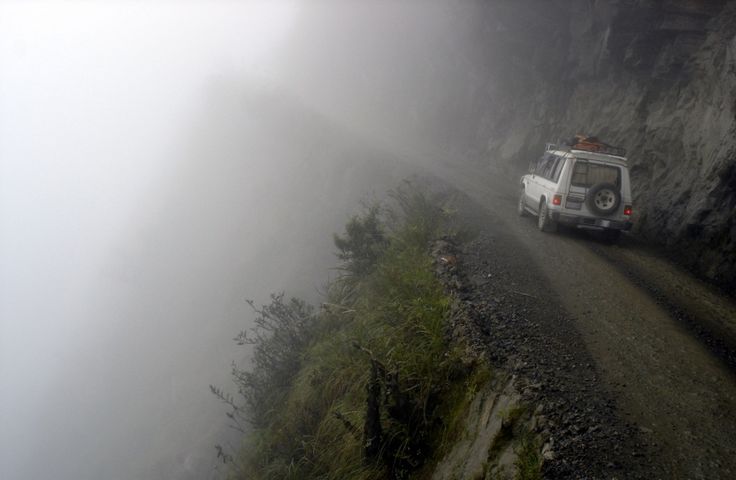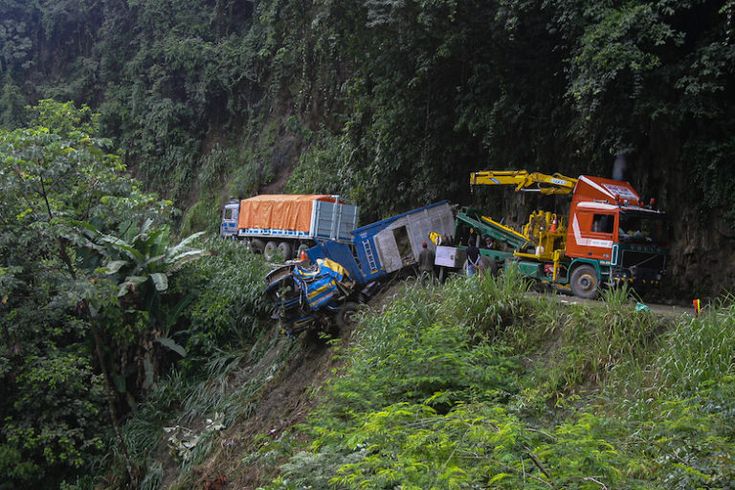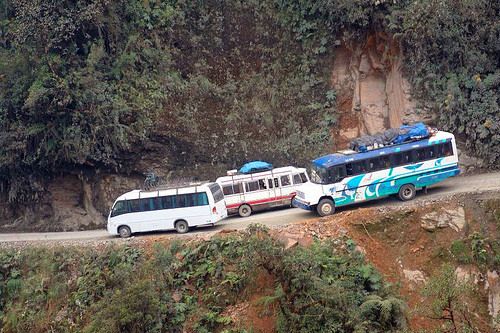Deep in the Bolivian Andes, hidden among the misty mountains, lies a road unlike any other. A road that will not only test your driving skills, but also your nerve, your luck, and sometimes your grip on life itself. This is the Yungas Road, a narrow ribbon of dirt and stone that was carved into the mountainside by those who created it.
With every sharp turn and every echoing sound it has sent through the jungle, this road has earned itself a chilling title. Locals call it the Death Road, and once you see it, you will understand why. For decades, this road has been known as one of the most dangerous roads in the world.
Imagine driving on a narrow dirt path that is barely wide enough for one vehicle, with fog clouding your vision, waterfalls spilling across your windshield, and a 2000-foot cliff looming at your side. Now add buses, trucks, and cars trying to squeeze past one another… on the same narrow road. That was exactly what drivers encountered on this infamous stretch.
With a little more than picks, shovels, and dynamite, they hacked out a narrow dirt trail along cliffs with no safety measures, no guardrails, nothing at all to ensure their safety.
Why was this treacherous road built in the first place? How did it become a symbol of tragedy? And how did it become an adventure hotspot for thrill-seeking tourists today?
Let’s take a journey into the dark history, chilling accidents, and surprising survival stories of Bolivia’s Death Road. Let’s go to the very beginning…
The Origins: Why Build a Road Through Hell?
The Yungas Pass was not built because someone somewhere was trying to be cruel; it was built out of necessity. Bolivia, a landlocked country high in the Andes mountains, needed a connection between its bustling capital city, La Paz, and the fertile Yungas region.

In the 1930s, during the Chaco War between Bolivia and Paraguay, Paraguayan prisoners of war were forced to carve this road into the mountainside. With a little more than picks, shovels, and dynamite, they hacked out a narrow dirt trail along cliffs with no safety measures, no guardrails, nothing at all to ensure their safety.
These prisoners carved out an impressive road, but it was also a death trap waiting to claim lives. From the beginning, this road was not designed for the faint-hearted. Trucks and buses drove on the road, navigating blind corners, hoping no one was coming from the other direction.
But someone was always coming from the other direction!
A Road Like No Other
So, what makes the Yungas Mountain Road so terrifying? Several things!
The road is a perfect mix of deadly conditions, which include:
- Narrow Width: A major part of the road is just 10 feet wide, which is barely enough space for a single vehicle. Yet buses and trucks once tried to pass each other on the same road.
- Steep Cliffs: On one side, the mountain looms above, while on the other side, cliffs plunge nearly 2,000 feet straight down into jungle valleys.
For decades, locals called it “Camino de la Muerte,” which means the Road of Death.
- Fog and Rain: At nearly 15,000 feet above sea level near La Paz, drivers often start in icy mountain fog, then descend into a humid and rainy jungle where waterfalls spill directly across the road.

- Mud and Landslides: Torrential rain makes the dirt road slippery. On the part of the mountain where this road is located, landslides are common, and sometimes they sweep vehicles into the abyss.
- Left-Side Rule: Unlike the rest of Bolivia, here drivers use the left side of the road, forcing them closer to the edge. The rule was put in place to help drivers see how close their tires were to the sharp edge of the cliff, but it didn’t make things any less nerve-racking.
This combination turned every trip on this road into a gamble. For decades, locals have called it “Camino de la Muerte,” which translates to the Road of Death.
The Deadly Reputation: Yungas Accidents and Tragedies
By the 1980s and 1990s, the accident that occurred on the Yungas road had become infamous worldwide. Some years, the road claimed up to 300 lives annually.
One of the worst tragedies occurred in the 1980s when a bus that was packed with more than 100 passengers went over the cliff; not a single person survived.
The victims ranged from local farmers heading to the market, to families traveling by bus, to truckers hauling goods across the mountains. Vehicles often skidded off the edge, especially during heavy rain. Just a single mistake, a tire slipping, a brake failure, or a poorly timed swerve, and dozens of lives could perish in one plunge.

One of the worst tragedies occurred in the 1980s when a bus that was packed with more than 100 passengers went over the cliff; not a single person survived. This single event gave the Yungas Road its reputation as the Death Road and one of the world’s deadliest roads.
Regardless of how experienced a driver was or how often they drove along that particular road, the danger was always the same: the mountain had a way of reminding them who was in control. Locals tell chilling stories of vehicles vanishing into the mist, their headlights visible for a few seconds before disappearing forever into the jungle below.
Those who survived crashes that occurred on this road often described the harrowing silence after the fall, broken only by the sound of rushing rivers and waterfalls in the depths.
In case you’re wondering why Bolivia didn’t build a safer road sooner, given the Yungas Road’s danger, the answer is simple: money and geography.
Bolivia is mostly made up of rugged mountains, and building roads on them was very difficult and expensive. For decades, the Yungas Pass was the only reliable route that linked La Paz with the Yungas region. That meant buses, trucks, farmers with donkeys, motorcyclists —basically, everyone had to risk it.
If you lived in the Yungas, the Death Road was your only way to get to the city for work, healthcare, trade, and even some groceries like bananas, coca leaves, or coffee in La Paz. In short, people did not drive along that Death Road because they wanted to; they did it because they had no choice.
The Survivors: Tales of Luck and Courage
While there are many tragic stories surrounding this road, there are also unbelievable survival tales that have made the road legendary. Drivers recount tales of how their brakes fail on the steep descent, and yet they somehow coast into a muddy patch that stops them from plunging off the edge.

Others tell tales of buses that tipped but got caught in the branches of jungle trees rather than falling the entire 2,000 feet, and a few who swerved and scraped their vehicles against the cliff wall instead of going over. Cyclists who survived also recounted tales of how they crashed off the road but managed to cling to vines.
All these stories became part of the folklore of the Yungas Pass, known for its survival stories. Many locals considered these experiences to be a test of fate. Some would pray or make offers before traveling because they believed mountain spirits decided who would pass through and who would fall.
The Turning Point: From Terror to Tourism
By the early 2000s, the situation had become too dire to ignore. International pressure began to mount, and Bolivia ultimately invested in a new, modern road complete with wider lanes, asphalt, and guardrails.
The Cotapata-Santa Bárbara highway opened in 2006. This new road provided a much safer alternative for heavy traffic. Most commercial vehicles and buses shifted to the new road, and the Death Road was no longer the main route it once was.
However, the story doesn’t end there. Instead of fading away or being totally abandoned, the road took on a new life. Today, Death Road has been reinvented, not as a highway of necessity, but as a playground for thrill-seekers.
Each year, tens of thousands of tourists from around the world travel to Bolivia to experience the Death Road tourism adventure, engaging in popular activities such as mountain biking. People now willingly pay to cycle down a road that was once infamous for claiming people’s lives.
For many people, it is the ultimate adrenaline rush, while for others, it is a chance to look danger in the eye and live to tell the tale.
The Yungas Road now features tour operators that offer guided bike tours, starting at the icy peak near La Cumbre Pass and descending over 11,000 feet into the tropical Yungas. Riders speed past waterfalls, splash through muddy stretches, and climb cliffs where the jungle drops away beneath them.

For many people, it is the ultimate adrenaline rush, while for others, it is a chance to look danger in the eye and live to tell the tale. Of course, biking down the Death Road is still not without risk; accidents do happen, but it is far fewer than in the days of heavy traffic.
At the end of the day, to these people, the thrill is in knowing that they are cycling on a road that history once called “the most dangerous in the world.“
Crosses still line the edge of the cliff as memorials to those who perished and every turn tells a story of how much life is balanced on the edge.
Why It Is Still Called the “Death Road“
Since traffic has been largely diverted, you would assume the name “Death Road” would fade away, but it didn’t, and probably never will.
The title “Death Road” is more than just a warning; it is part of the road’s identity. To locals, it is a reminder of the loved ones they lost. To travelers, it is a badge of courage, and to history, it is a symbol of how humans carve out survival in impossible landscapes; it shows how well humans can adapt to almost anything.
Even though modern engineering has made travel safer, the scars this road gave to people who were affected remain. Crosses still line the edge of the cliff as memorials to those who perished, and every turn tells a story of how much life is balanced on the edge. That is why, even today, the name “Death Road” still sticks. It is not just about the accidents; it is about the legacy.
Conclusion: The Symbolism of Death Road
The Yungas Pass is more than just a road; it is a metaphor for Bolivia itself—a country of extremes, where breathtaking beauty and deadly danger coexist side by side.
On Death Road, you witness the same line between life and death, progress and peril, human determination and Mother Nature’s fury. It represents the resilience of those who built it, the tragedy of those who lost their lives, and the adventurous spirit of those who still dare to face it today.
Yungas Pass, a road once carved by prisoners of war, became a stage for tragedy, survival, and ultimately, reinvention. Today, we know it as both a memorial to those who died and a magnet for those who crave the thrill of conquering the unconquerable.
So the next time you hear about roads that test the limits of human courage, remember the Yungas Road.
What do you think… would you dare to take on Bolivia’s Death Road? Let us know in the comments.
Sources and Further Reading:
- Yungas Road featured by BBC Travel → BBC Travel (2022: “The world’s most dangerous road”)
- North Yungas Road details and “treacherous road of death” → WorldAtlas article (2017: “North Yungas Road – the Most Dangerous Road in the World”)
- Death toll estimates (200–300 annually) → The Sojourn (Yungas Road; up to 200–300 yearly in 2006)
- Inter-American Development Bank naming it “world’s most dangerous road” (1995) → ResearchGate article referencing the IDB feasibility study
- Bus accident in 1983 with 100+ deaths → Camel (Yungas Road; records July 1983 bus crash)

